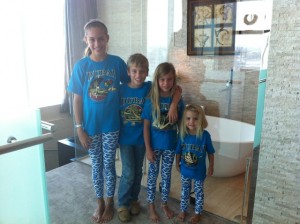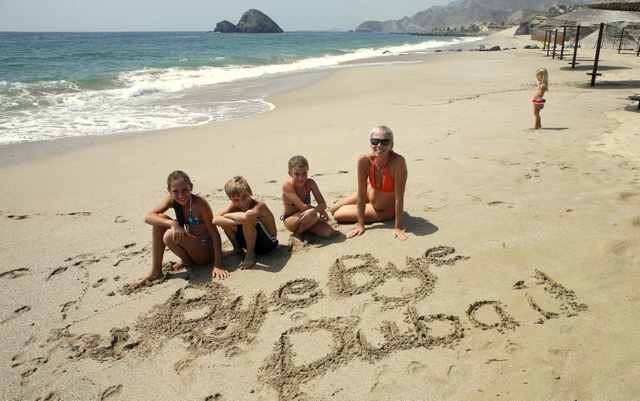Our last couple of months in the Middle East take us on an extraordinary adventure from the wild coast of Oman to the edge of the vast Empty Quarter on the border of Saudi Arabia and back again to the madness and glamour of Dubai’s metropolis.

Our first journey takes us to the most easterly point of Oman, Ras Al Jinz. Here we watch one of the wonders of the
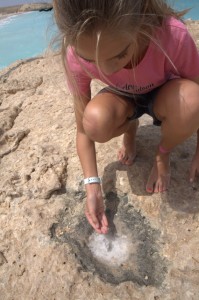
natural world – the nesting of green turtles. Along this coastline, in contrast to the gently sloping, continental shelf of the Arabian Gulf and Northern Gulf of Oman, there are trenches and canyons forming underwater cliffs several kilometers high, resulting in an astonishing diversity of marine life. Oman’s waters have some of the greatest seasonal variability found anywhere in the world – the winter monsoon (known locally as Shamal) and the summer monsoon (kharif). Anyone who watched the BBC’s Wild Arabia programme would have seen the incredible affect that the kharif has on the southern end of Oman, Salalah, when it transforms, almost overnight, into a verdant paradise that you would never believe belonged in this region. The edge of this monsoon brings much cooler temperatures and high winds to the area we are heading for, just 200 km east of Muscat.
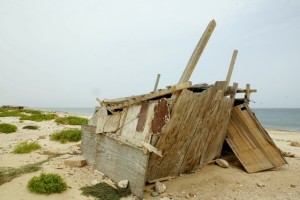
Passing Muscat we start to follow a coastal road, where the turquoise Indian Ocean meets the rocky land. We pass fishing huts, although as it is during Ramadan, there are few people about and we have discovered
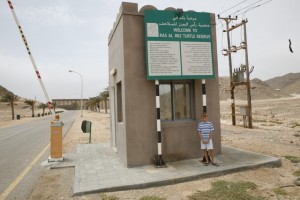
that the daylight hours of Ramadan make for perfect driving on empty roads! The road heads back inland but eventually we take a turn back towards the ocean and the Ras Al Jinz Turtle Reserve. The Reserve
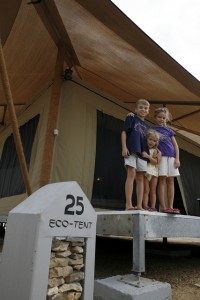
is within a 45km stretch of coastline that in 1996 was declared a ‘reserve’ by Royal Decree, specifically to protect sea turtles. Around 30,000 Green Turtles nest here annually and the site is of global importance.
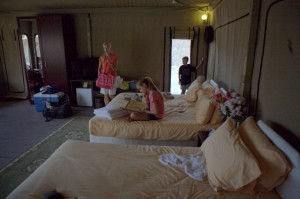
As the only guests this particularly evening (a complete fluke, as the night before the guides took 100 visitors to the nesting area; but how incredibly fortunate for us), we have our choice of accommodation and stay at the top of a hill in a rather fabulous tent structure, overlooking the mesa where archeological sites of fishing villages and cairn graves have been found dating back 5,000 years. The
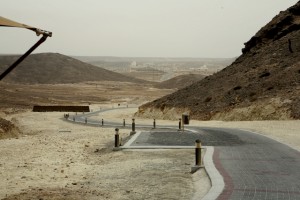
oldest incense burner ever found was also discovered here. At the late hour of 10 o’clock, we head out (with all the Tribe) into the very windy, very black (there is complete cloud cover tonight) and rather
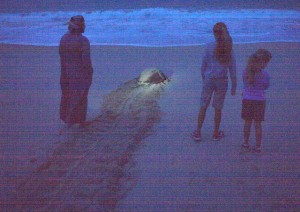
cold night, back to the main building where our Omani hosts meet us. We realise that we are incredibly fortunate to have this private viewing tonight and we soon find ourselves bumping across the sands
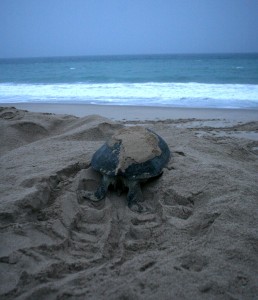
towards the nesting ground. As we get out of the jeep, just ahead of us, we get our first glimpse of a green turtle in the guide’s flashlight. It is quite simply, awesome and it quite takes my breath away. The Tribe are filled with awe. Turtles spend most of their lives at sea, nest on land, returning to nest on the same beach that they were born on. The females reach maturity at between 37 and 49 years
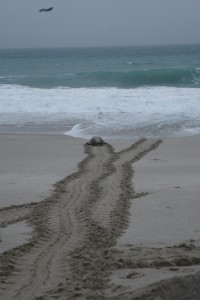
– scientists are still researching how they find their way back after so long. Although beautifully graceful in the water, seemingly flying through the ocean, on land, the turtles are slow and cumbersome. But, when the time is due, the turtles will determinedly leave the water, climb the beach and doggedly dig a circular hollow, up to a meter deep, with their flippers, before laying around 100 spherical, white eggs the size of a golf ball, in about 15 minutes. This is what we are privileged enough to watch. The
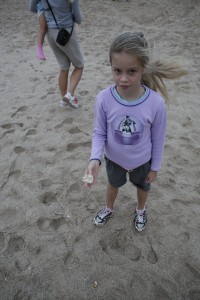
effort is immense and my heart goes out to the female turtle as we stand behind her watching the eggs drop into the pit. Her body heaves with the effort. Mucus gathers in her eyes, giving the impression that she is crying. It is extraordinarily moving. Once finished the mother uses her flippers to cover the eggs with sand to protect them from predators. While watching one turtle, we notice a sudden movement and the guide points to a pair of glowing eyes in the dark – an Arabian fox. The guide intervenes throwing a stone at the fox. Before returning to the water, the turtle digs another hole to act as a decoy and to camouflage the real nest.
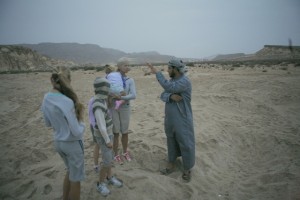
We learn that if a female nests too low down a beach, the eggs can be flooded. The warmth of the sand incubates the eggs and also determines the sex of the hatchlings. Warmer temperatures
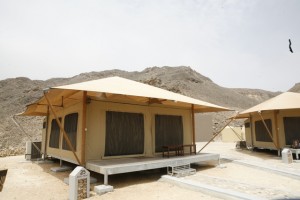
produce females, cooler produces males and intermediate temperatures give a mix of both. After about 55 days, the hatchlings emerge and work upwards, the top ones scraping the sand which filters
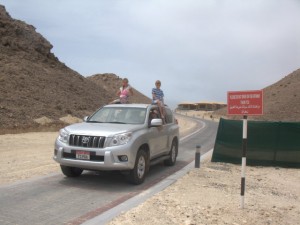
through the eggs below and is trodden down so the whole group rise together finally reaching the surface after 3-5 days. The best time for the hatchlings to dash to the sea is at night; the first year is a very unknown time, known to scientists as ‘the lost year’.
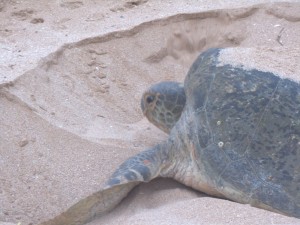
Seeing these tiny hatchlings later when we return to the beach at dawn break, we marvel at how they grow to such an immense size despite all the odds that are stacked against them – the desperately depressing statistic is that only one out of every 100 hatchlings survive to maturity. Despite all the females work, there is absolutely no maternal instinct; once the eggs are laid, the females’ job is done The Tribe have learnt an amazing lesson in how man really does need to help some species to survive the modern world.
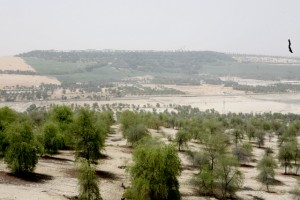
Another trip takes us inland to the Liwa Oasis on the northern edge of the Rub Al Khali, otherwise known as the Empty Quarter. The Rub Al Khali is the world’s largest sand area taking up a fifth of the Arabian Peninsula or 583,000
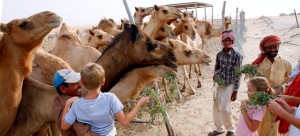
square kilometers (larger than France), running through Saudi Arabia, Oman, Yemen and the UAE. The Sahara is 15 times the size of the Empty Quarter, but is
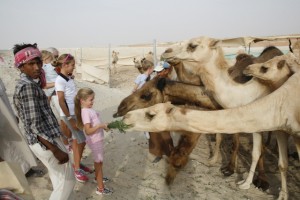
primarily made up of rock and gravel plains. Wilfred Thesiger, the explorer, crossed the Empty Quarter several times between 1945 and 1949, always resting in Liwa. His book recording
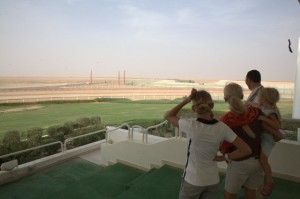
these amazing journeys, makes fascinating reading. What strikes us at Liwa is how incredibly green the area is – great swathes of vegetation suddenly stop as the great desert and sand dunes begin. The Liwa Oasis is made up of a
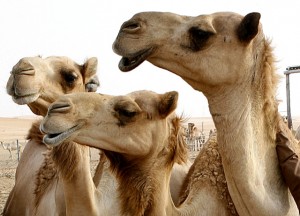
100km crescent shaped chain of 50 villages and is the most southern point of Abu Dhabi and the birthplace of the rulers of Abu Dhabi, the Bani Yas tribe. Bedouins tapped underground freshwater to cultivate dates
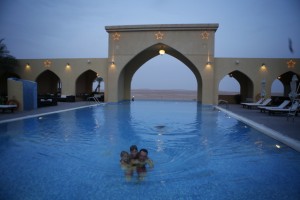
and 40 villages appeared before the 16th Century. However, with the rise of the pearl industry, Liwa lost its economic importance and the Bani Yas family moved to Abu Dhabi during the early 1790s. After the
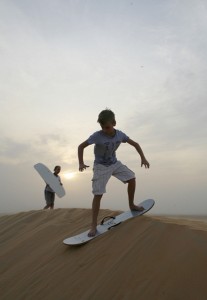
wild East coast of Oman, the silent, beautiful, but deadly desert is in utter contrast. We leave the desert behind only after the Tribe have had an absolute ball, sand boarding in the dunes in 40 degree heat!

I cannot think of enough superlatives to describe our final couple of weeks in the crazy emirate that is Dubai, but it has been the most amazing adventure of our lives and we would, without a doubt, do it all over again.
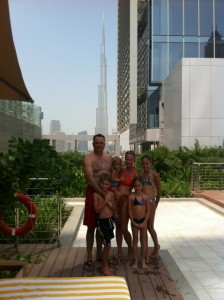
The Tribe did manage to visit the world’s tallest building and we even managed to take them to breakfast at the world’s tallest hotel.
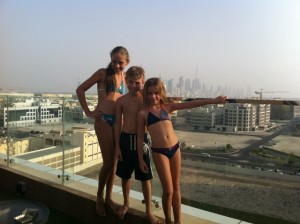
After an administrative error we also ended up staying in the Presidential suite of our final hotel before returning to Abbotts Ann. As the saying goes, ‘Only in Dubai!’.
